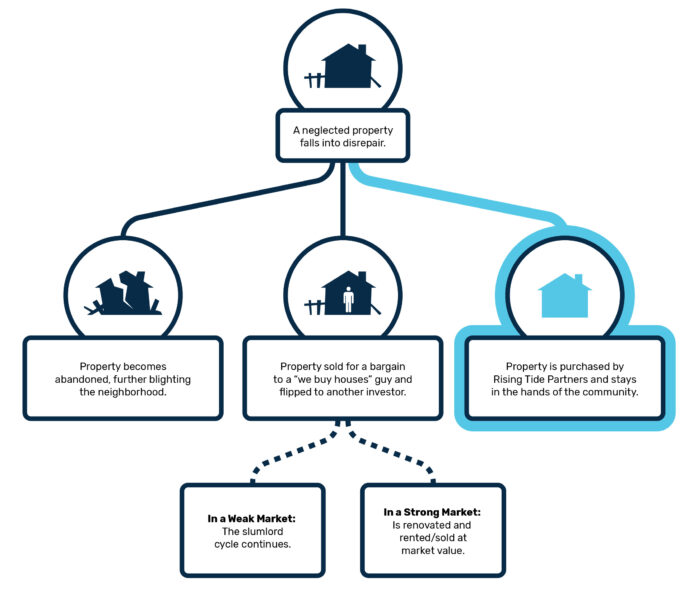The Need
The key to protecting vulnerable residents, and minimizing displacement is to control problem properties early in the development process and directly address the needs of families. By working at the scale of the problem we ensure residents are protected and that restoration actually happens.
What We Know
- Real estate is crucial to improving outcomes for families
- Site control is necessary to implement community visions
- Community-based organizations can be destabilized when taking on too much real estate risk.
Crime is a real estate problem
- 50% of crime happens at 3% of properties
- Policing systems are not sufficient to tackle the crime hot spots that absentee landlords create.
- By owning the properties we can implement restorative approaches with property management, residents, police and community partners.
- Research has shown that this approach can transform public safety.
Naturally affordable rental housing needs to be protected through non-profit site control
- If the real estate market improves without control of these properties, profit-motivated landlords will cause displacement.
- Market success, without affordable housing protections and wealth building for long-term residents, may achieve a safer and more desirable neighborhood, but come at the expense of displacing the very residents the community cares about.
Below is a more detailed breakdown of the path to displacement.
THE PROBLEM
Housing displacement of low-income families occurs in both strong & weak markets, as a result of decisions made by landlords and homeowners.
Strong Housing Markets: Gentrification
A distressed neighborhood finally starts to improve after years of hard work.

LANDLORD DECISIONS
- Property is neglected for years
- Absentee landlords see opportunity to sell/renovate
- Tenants are evicted
- Property is renovated by the new or existing owner
- House is rented or sold at market rate

HOMEOWNER DECISIONS
- Can’t keep up with repairs and house deteriorates
- Not knowing market value, they sell at a bargain
- Generational wealth is lost
- Purchaser flips for a small profit
- New investor renovates & rents/sells at market rate
Result: In both cases low-income families are displaced.
Weak Housing Markets: Rotrification
Systemic injustices foster blight, crime (or perception of crime), and lack of investment.

LANDLORD DECISIONS
- Property is neglected for years
- Bad conditions cause tenants to move out
- Landlord stops paying taxes/mortgage and the bank decides it’s not worth foreclosing.
- Property sits abandoned, blighting the neighborhood
- Eventually it’s demolished & becomes a vacant lot

HOMEOWNER DECISIONS
- Can’t keep up with repairs and house deteriorates
- Eventually moves out and sells at a bargain
- Generational wealth is lost
- New owner patches it together & rents in poor condition
- Bad landlord cycle continues until the house goes vacant and is abandoned
Result: Both scenarios negatively impact the neighborhood
Where We Come In

01
We take real estate risk to achieve community visions
02
We address the riskiest real estate, including abandoned properties that are costly to repair, and slumlord properties that are harming tenants
03
We can borrow capital to do good with the riskiest real estate which is difficult to manage
In conclusion, Rising Tide Partners is set up to take real estate risk, which shields community institutions from failure if things don’t go well.
